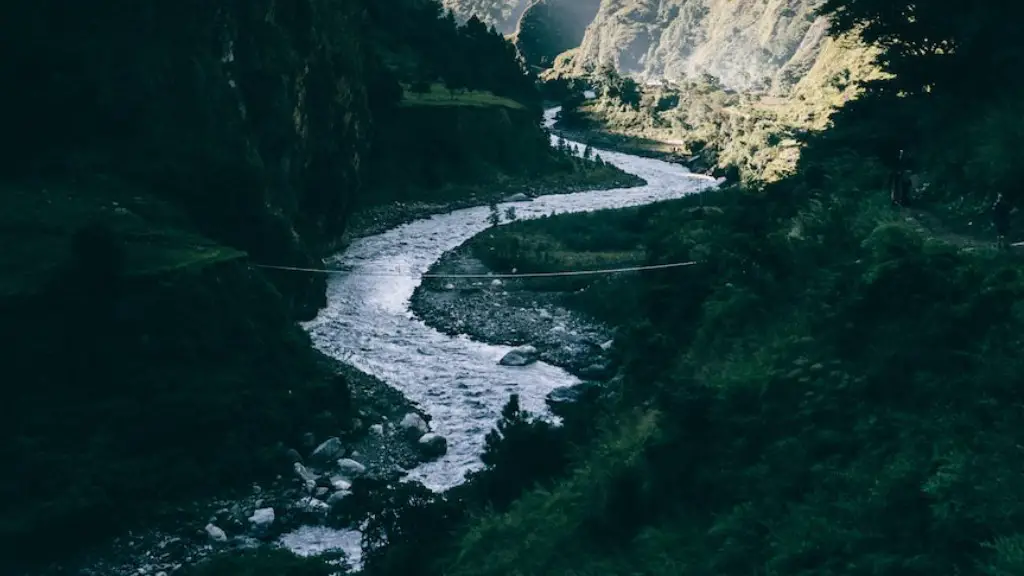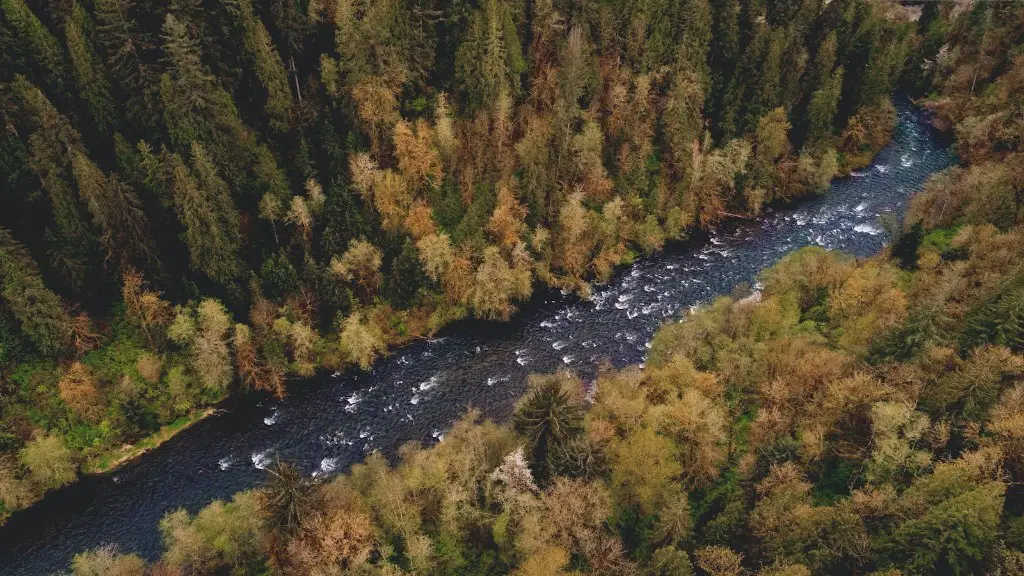The Amazon River is the world’s largest river by discharge volume of water. It is located in South America and runs through the Amazon rainforest. The river is about 6,400 kilometers (4,000 miles) long, and its basin (the area of land where water from the river drains into) covers an area of about 7 million square kilometers (2.7 million square miles). The Amazon River is one of the most biodiverse places on Earth. The river is home to many different animals, including some that are found nowhere else in the world. However, the river is threatened by pollution and other human activities.
The Amazon River is not sustainable.
How does the Amazon river affect sustainability?
The Amazon’s hydrological engine is a major factor in maintaining global and regional climate. Water released by plants into the atmosphere through evapotranspiration (evaporation and plant transpiration) and to the ocean by rivers influences world climate and the circulation of ocean currents.
Sustainable management strategies are important to ensure that people today can get the resources they need while also preserving the ecosystem for future generations. However, these strategies can be affected by political and economic factors.
Are there any environmental problems with the Amazon river
The Amazon is the world’s largest tropical rainforest, spanning over five and a half million square kilometers across nine South American countries. It is home to an estimated 390 billion individual trees, over 16,000 species of plants, and countless species of animals. The Amazon is a vital part of the global climate, providing 20% of the world’s oxygen and absorbing 2 billion metric tons of carbon dioxide each year.
Yet despite its vastness and importance, the Amazon faces a deluge of threats: a dam-building spree across the basin is disrupting fish migration and nutrient cycling, large-scale deforestation is destroying habitats and increasing sedimentation, pollution from mining and agribusiness is affecting aquatic ecosystems, and climate change is causing droughts and wildfires. These threats are putting the Amazon’s future at risk and jeopardizing its vital role in the global climate.
The study, published in the journal Science, says that the average size of fish caught in the Amazon has declined by about 20 percent since the 1970s. The researchers say this is likely due to overfishing and changes in the region’s ecology.
The findings highlight the need for improved management of the Amazon’s fisheries, the authors say. They add that the decline in fish size could have ripple effects on the region’s food security and economy.
Why is the Amazon river important to the environment?
The Amazon river is one of the most important rivers in the world. It contains a huge amount of fresh water, which is vital for the planet. The Amazon also supports a large number of plant, animal, and insect species. This makes it an important habitat for many different species.
Tropical rainforests are among the most threatened ecosystems on Earth due to deforestation. Deforestation of tropical rainforests can be reduced by managing the forests in a way that preserves the rainforest canopy. One method of doing this is selective logging of mature trees. This ensures that the forest can recover because the younger trees gain more space and sunlight to grow.
Does Amazon support the environment?
We’re committed to powering our operations with 100% renewable energy by 2025 and reducing our net-zero carbon emissions by 2040. We’re making significant investments in renewable energy and electric vehicles to help achieve these goals. We’re confident that these investments will create a cleaner, more sustainable future for our business and the planet.
Fossil fuels are one of the leading causes of climate change, so it’s important to reduce our use of them as much as possible. One way to do this is to support and demand renewable energy in our areas. Another way is to turn off electric appliances when we’re not using them. By taking these steps, we can help reduce our impact on the planet.
How can we make the Amazon rainforest more sustainable
As the world’s largest tropical rainforest, the Amazon is essential to our planet’s health. And yet, it’s under threat from deforestation, climate change, and exploitation.
Here are 7 ways you can help save the Amazon and the world’s rainforests:
1. Reduce your paper and wood consumption
2. Reduce your oil consumption
3. Reduce your beef consumption
4. Hold businesses accountable
5. Invest in rainforest communities
6. Support the grassroots
7. spreading the word and raising awareness
Climate change appears to be increasing the occurrences of both floods and droughts around the world. In the Amazon Basin, droughts have become more frequent and more severe in recent years, while torrential downpours and floods have become more common in other locations. It is not clear why this is happening, but it is likely that climate change is playing a role. More research is needed to better understand the impact of climate change on extreme weather events.
How polluted is the Amazon river?
It is estimated that the Amazon River is responsible for 32000-64000 tons of plastic pollution in the Atlantic Ocean every year. This is a significant amount and highlights the need for more research into the pollution problem in the Amazon.
The study, conducted by World Wildlife Fund (WWF) and Climate Analytics, reveals that oil and gas extraction in the Amazon and Congo Basins could emit over 4 gigatonnes (GT) of carbon dioxide equivalent (CO2e) into the atmosphere every year by 2050 if current rates of expansion continue – equivalent to the emissions of almost 1,000 average coal-fired power plants.
The report shows that the production of just one barrel of oil from the Amazon emits on average three times more CO2 than a barrel of oil from the Middle East, and produces 100 times more emissions than a barrel of oil from North America.
The majority of this expansion is happening in the Amazon Basin, where oil and gas development has already led to the deforestation of nearly 4 million hectares of rainforest. If current rates of expansion continue, an additional 22 million hectares – an area the size of England – could be lost by 2050.
This would not only be disastrous for the Amazon’s ecosystem and the incredible biodiversity that call it home, but would also release huge amounts of CO2 into the atmosphere, further exacerbating the climate crisis.
The report makes a number of recommendations to prevent this expansion, including a moratorium on new oil and gas
What is the most overfished place in the world
The Mediterranean Sea is the most overfished in the world, with 62% of its fish stocks now overfished and at serious and real risk of being depleted. Nobody wants a sea so familiar to many of us to have no fish for people to eat or no more jobs and livelihoods for those who depend on fishing in the region. We must all do our part to reverse this trend by changing the way we fish, ensuring that fish stocks are managed sustainably, and by investing in alternatives to destructive fishing practices.
It is estimated that if nothing is done to stop the destruction of the Amazon rainforest, 40% of it will be gone by 2050. The Amazon is home to many unique plants and animals, and its destruction would have a devastating impact on the environment. We must do everything we can to protect this vital ecosystem.
How much waste is in the Amazon river?
It is estimated that about 60,000 tonnes (66,000 tons) of plastic are carried into the Atlantic Ocean by the Amazon River every year. This plastic pollution poses a serious threat to the marine environment, as well as to the wildlife that lives in it.
The Amazon rainforest is one of the most important ecosystems on earth. It is home to an incredible diversity of plant and animal life, and it plays a vital role in regulating the global climate.
If the Amazon’s cloud systems and its capacity to recycle water were to be disrupted, the ecosystem would tip over and irreversibly turn into dry savannah very quickly. Estimates of where this tipping point could lie range from 40% deforestation to just 20% loss of forest cover from the Amazon.
This would be a devastating blow to the planet, and would cause irreparable damage to the climate. It is essential that we do everything we can to protect the Amazon rainforest, and to ensure that it remains a healthy and thriving ecosystem.
Final Words
The Amazon River is not sustainable.
The Amazon River is one of the longest rivers in the world and is home to a large number of plant and animal species. The river has been under threat in recent years due to the increased demand for water and the pollution caused by human activity. However, the river is still a vital part of the ecosystem and is essential to the survival of many species. The Amazon River is a valuable resource that must be protected.





